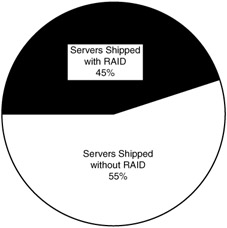Chapter 6: Disaster Recovery and Disk Management
|
| < Day Day Up > |
|
While disaster recovery planning (DRP) gets a lot of lip service these days, a surprisingly large number of organizations have failed to fully understand and/ or implement a comprehensive DRP. Simply put, every organization should have a sound DRP that will function if ever needed and that goes way beyond RAID and backup. Yes, the impressive capabilities of modern RAID arrays and the sophistication of backup procedures can make it appear that no matter what data loss occurs, IT is covered for all eventualities. Yet, there are gaping holes waiting to be exploited. This chapter takes a look at the many elements of DRP and how to implement one so that the data is safe and easily recoverable. Also discussed is a contingency plan (CP) that applies to non-catastrophic failure due to accidental deletions, disk failures, and other potential data loss scenarios. By creating and implementing a CP, organizations are better able to eliminate data loss and downtime due to non-catastrophic failures such as disk crashes and deleted documents. Further, a CP gives an organization a better understanding of the many intricate details involved in any DRP so that the eventual plan is more fitted to the real world and may actually function adequately in times of catastrophe.
Is Your Data Really Protected?
To hear some people talk, one would think that data protection is now an accomplished fact. With RAID on the servers, adequate backup, and a decent firewall, we can rest easy knowing our data is secure. Yet, the surprisingly high rates of disk failure in organizations and the associated high rates of data loss attest to the fact that, despite RAID and backup being in place, these tools appear to have been about as effective as throwing stones at a division of Panzer tanks when it comes to serving as a means of protection against data loss or worse, catastrophic failure.
Yet, the appeal of addressing data loss through built-in disk redundancy can be seen in the pervasiveness of RAID-based servers. According to Gartner Group (Stamford, Connecticut), 21.8 percent of all Intel servers shipped in 2000 had no RAID, 17.9 percent had OS software RAID (mainly Novell and MS systems), 53.3 percent had hardware RAID utilizing an internal RAID controller, and 7 percent had externally controlled hardware RAID. Breaking it down by market segment, today 100 percent of servers in the $10,000+ price range have hardware RAID, 98 percent of the $5000 to $10,000 server bracket have hardware RAID, and 45 percent of the sub-$5000 server range have hardware RAID (see Exhibits 1 and 2).
Exhibit 1: RAID-Based Servers Shipped in 2000

Exhibit 2: Servers Below $5000

These statistics reveal the value placed on RAID technology. Not only does it accelerate I/O by simultaneously reading/writing to multiple disks, but it also preserves data by replicating it among disks. Although RAID is a great last line of defense, it has definite shortcomings. If a disk does go down, performance suffers badly until it is replaced and the data structure rebuilt. And, if more than one disk fails at the same time, the system is really in trouble. Further, RAID is largely a high-end server resource — 55 percent of low-end servers and close to 100 percent of workstations and laptops do not have RAID. Consequently, end-user hard disk failures are tolerated as a necessary evil.
Unfortunately, backup is not foolproof, either. For example, if a system is backed up every weekend, then any data newly written during the following week is subject to being completely lost; if the back up is performed on Sunday and new data is written on Monday and lost on Tuesday, then it is really lost, as it does not exist on any backup tapes. Even if the frequency of backups is increased, the same thing can still happen, just on a smaller scale. Imagine telling the boss that the 30-minute speech he spent all day writing then accidentally deleted is gone! And heaven help you if you have to rummage through tapes looking for specific documents. After hours of thankless work, you may end up finding the correct tape only to discover that the file being sought was not backed up or the media itself is faulty. A survey of 260 IT professionals found that only 38 percent of all tape backups retrieved all the data needed. Like RAID, backup is an essential system that everyone should implement, but it is far from the ideal solution for the problem of data loss and is only a small part of a comprehensive DRP.
Another problem with backup has arisen due to the tremendous growth of a mobile workforce. Over the years, companies have learned to keep critical information on servers rather than workstations and to back up servers daily; however, much of the day-to-day operational data is no longer on the network but is stored in the millions of laptops people carry around. Laptops might get backed up when they connect to the network, and maybe users will remember to back them up themselves, but then again maybe they won't. Given the abuse they take out in the field, laptops are more subject to drive failures than machines sitting in the office.
If backups were a total solution, then the market for data recovery software would not be so huge nor would so many companies be offering their services to recover data from hard disks and tapes. Although backup can be regarded as an essential element of data protection, it really is a last-line defense tool.
|
| < Day Day Up > |
|
EAN: N/A
Pages: 197